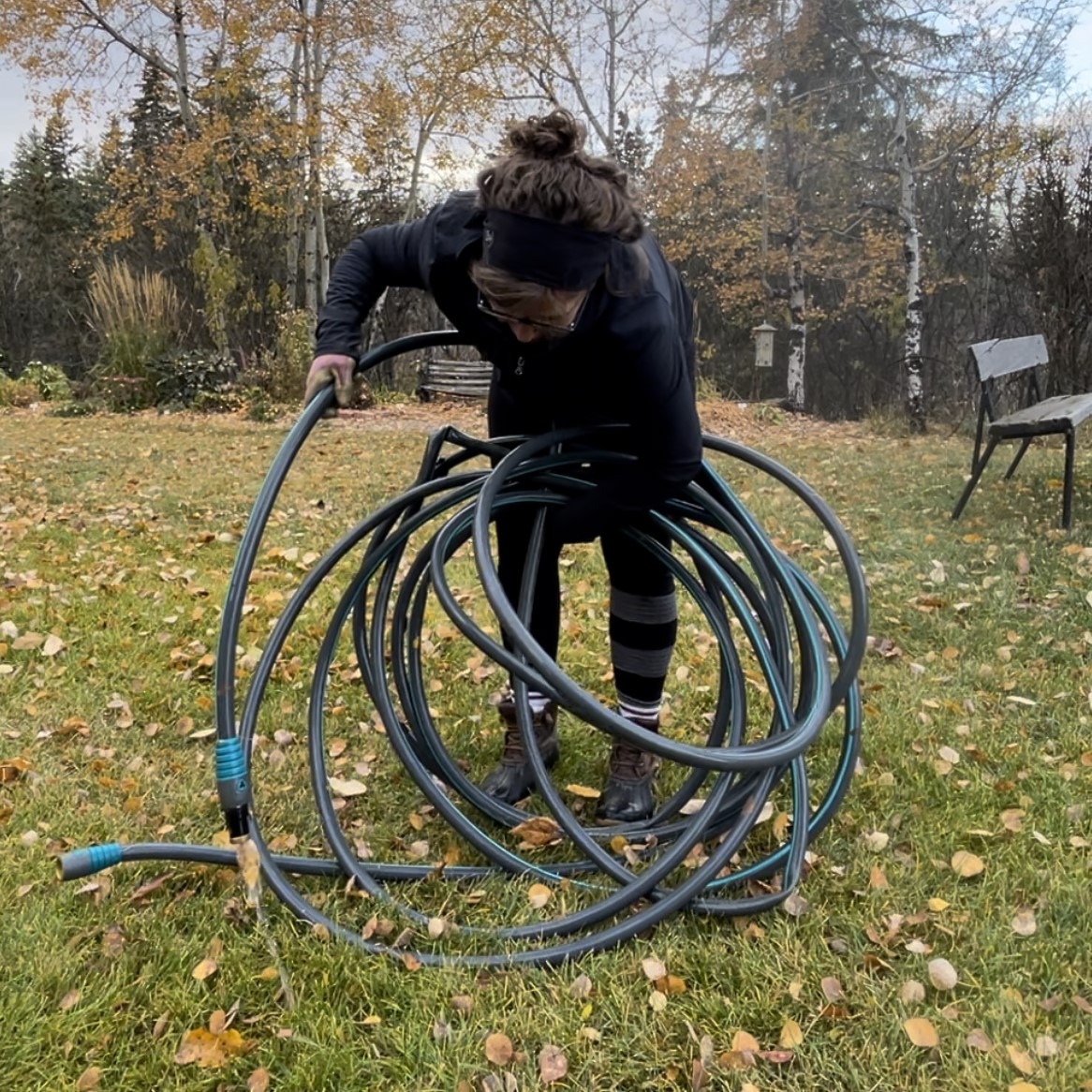Autumn is an excellent time to reflect on your garden’s successes and challenges and to begin getting ready for winter. Good fall clean-up gives a healthy start to the following spring.
In this blog, I will outline three perennial garden clean-up strategies along with the pros and cons to each in terms of labour output, soil health, plant health, and impact on insects and pollinators.
Before we delve into the fall clean-up options, here’s an essential checklist of things to do regardless of the fall clean-up approach you ultimately choose:
Fall Cleanup Essentials Checklist

Take Good Notes About Your Garden
One of the advantages of living on the prairies is that we get a winter break from our gardens which gives us time to reflect on them, and we get a ‘do-over’ the following spring.
Maintaining a detailed log about your garden is your most powerful tool to improve next year’s gardening success.
Whether your gardening space is many acres big, a small townhouse space, or a balcony doesn’t matter; keeping track of what has happened during the year will help you make wise decisions for your next opportunity.
Find a notebook (maybe one with an awesome flowery cover ☺ and start writing, or you may prefer to have a digital file. If you photograph your garden, those pictures also serve as notes.
Ask questions like these to compile your journal:
- Which plants worked well? Which plants would you repeat?
- Which plants performed poorly? Which plants would you scrap from your landscape?
- What are your thoughts on the causes? This would be a great space to note weather and rain patterns during that particular season.
- Which were your favourite annuals and perennials?
- How often did you fertilize? Which fertilizer(s) did you use?
- What are your dreams for next year?
- Which new plants would you like to try?
Fall Cleanup Tasks for Any Garden


No matter how large or small your garden, here is a list of tasks that will get your yard ready for the coming winter:
- Autumn is an excellent time to make new flower beds.
- Put finishing touches on mulching – maintain mulch at 2-4 inches (5-10 cm).
- Water deeply – water perennials generously once or twice a week – always remember to assess the hydration level before watering so you know whether you are underwatering, overwatering, or supplying just the right amount of water.
- Start thinking about which plants need winter protection.
- Clean tools in warm soapy water; bleach is unnecessary.
- Rinse out & roll up hoses.
- Sharpen your gardening tools.
- Clean up power equipment like hedge trimmers, weed eaters, leaf blowers, and lawnmowers.
- Remove hanging baskets and planted containers as they wane and compost the plant material.
- Wash patio pots – plastic and ceramic – with warm soapy water.
- Store ceramic pots that are sensitive to winter cold in a warm storage area. Ceramic pots that haven’t been glazed for our cold winters may crack.
Let’s Look at the Three Different Perennial Garden Fall Cleanup Strategies:

There are three basic garden clean-up options for fall.
Each technique has its advantages and disadvantages, and each strategy will include a description of the approach and an analysis of the pros and cons of each in terms of:
- labour output
- soil health
- plant health
- impact on birds, insects, and pollinators
Hydration has a significant impact on perennial survival. Make certain that your perennials are well hydrated before going into the winter months.
1. The ‘Let it Go’ Strategy – think ‘Elsa’

The Method
Can you hear the song in your head?
For this approach, everything in the garden is left where it stands, both annuals and perennials.
Let fall settle in, celebrate your garden and enjoy autumn, let winter come as it may, and drink warm cider by the fire.
Some people feel that this kind of winter garden look is unsightly. Not everybody loves this idea, and some think it looks like a brown, messy, dead-looking garden all winter.
Labour Output
The labour output with strategy is minimal in the fall. Spring holds most of the workload.
Impact on Soil Health
This method is very healthy for the soil.
It allows the natural mulching of leaves to stay in the garden which provides nutrients for the earth.
The annuals and perennials catch snow and encourage it to accumulate and settle on the garden, and the more snow that collects, the more moisture is available to the ground as it melts in the spring.
Impact on Perennial Health
Letting perennials die naturally to the point where their leaves turn bronze is the best practice to bolster perennial root health.
The leaves will continue to photosynthesize and send nutrients to the root ball until it is no longer possible. The natural mulching on the garden surface and snow accumulation provide insulation through the winter and hydration to perennial roots in the spring.
Impact on Birds, Insects, & Pollinators
As we become more aware of our gardens’ impact on birds, insects, and pollinators, this method provides the maximum protection and habitat.
Birds will scavenge for seeds, and insects will have plenty of habitat for burrowing.
2. The ‘Scorched Earth’ Strategy – think ‘Rambo’

The Method
I call this strategy scorched earth because nothing is left standing in the garden except for trees and shrubs.
In this method, all perennials are cut down to about 6 inches from the ground and all annuals are removed. This method allows for a fresh start from ground zero in the spring.
Labour Output
With this approach, the bulk of the work happens in the fall with very little work in the spring. It eliminates having to deal with messy plant material in the spring, which is a huge positive for some people.
Impact on Soil Health
This technique has the potential to be less effective at bolstering soil health.
With fewer stems and plants available to collect falling leaves, fewer nutrients will be available to the soil. The possibility of snow accumulation and holding capacity is reduced in this method because there aren’t any plant structures available to catch snow and prevent it from drifting off the flowerbed.
Impact on Perennial Health
Photosynthesis in the leaves sends nutrients to the roots as far into autumn as the plant can continue. The amount of nutrients that ultimately get to the roots in this method depends on when the leaves and stems are cut back in the fall.
With the potential for less mulch and snow, there will be less perennial protection through the winter and hydration in the spring.
Impact on Birds, Insects, & Pollinators
With the limited plant structures left in this approach, habitat and protection available for birds, insects, and pollinators is reduced.
3. The ‘Meeting in the Middle’ Strategy – think ‘Goldilocks’

The Method
This technique is a middle ground between the two approaches described above and you get to craft your winter garden-scape.
This method is a good ‘in between’ idea for people who feel an entire garden of dead-looking plants isn’t for them.
In this technique, you get to let the perennials that have the best winter interest stay in place and whether or not you will leave the annuals in if you have any.
Instead of cutting perennial stalks back to 6″ (15cm), leave them at 12″ (30 cm) to allow for more insect habitat.
Perennials that provide excellent winter interest are usually tall and sturdy like:
- Baptisia (False Indigo)
- Dictamnus (Gas Plant)
- Echinops (Globe Thistle)
- Heliopsis (False Sunflower)
- Perennial Grasses
- Solidago (Goldenrod)
- Tall Fall Blooming Sedums (Stonecrop)
Be strategic and pick the perennials that will capture the most snow possible, even if it means leaving an atypical perennial uncut. You can sculpt a beautiful winter scape and yet maximize winter protection, take advantage of spring moisture, and level out the amount of work required in the autumn and the spring. It’s nice to have a pretty winter garden to enjoy during our coldest time of year.
Labour Output
With this approach, the workload is evenly divided between fall and spring. It provides the opportunity to split tasks between the two seasons.
Impact on Soil Health
This method promotes soil health as leaf and snow holding capacity is nearer to the ‘Let it Be’ Method.
Impact on Perennial Health
The impact of this approach is right in the middle. Some perennials will have the advantage of a full autumn of photosynthesis, where others will not. The level of winter protection and snow cover depends on the extent to which perennials are left to stand and how many are cut back.
Impact on Birds, Insects, & Pollinators
As with the above notes, how this strategy will affect birds, insects, and pollinators depends on what is left to stay and what is cut down. The more plant material left standing, the better the habitat for them all through the winter. Higher stalk heights will allow for more insect habitat, and perennials that are left standing will provide food for birds.
What’s Your Fall Gardening Alter-Ego?

As we wrap this up, I want to acknowledge that we all live different lives, and the beauty of horticulture is that it is pliable, meaning that there is often more than one answer to solve a problem.
I’d like to encourage you to choose the fall clean-up strategy that works best for your life and the life of your garden. There is no guilt here for the choice you make, my hope is that with this blog, your decision is an informed and comfortable one that fits best for you.
©Sharon Wallish Murphy ©Gardening with Sharon































